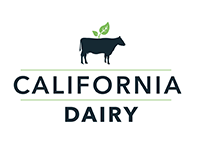Researchers at UC Davis conducted a life cycle assessment (cradle to farm gate) of California dairy farm production, using the latest scientific models and international research standards. The results showed that the amount of water used per gallon of milk produced decreased by more than 88 percent between 1964 and 2014, primarily due to improved feed crop production and water-use efficiency.
The largest contributor to water usage is water used for crops. The research documented that water use for irrigation has declined steadily since the 1960s, even though irrigated acreage has increased. Improved crop genetics and management have contributed to large efficiencies in water utilization. Irrigation practices have been adopted to improve uniformity of water distribution and efficiency of water delivery with a net benefit of less water needed per unit of crop farmed.
There was an approximate 40 percent reduction in on-farm water use in 2014 compared to 1964. Improvements in milk equipment such as vacuum pumps and plate coolers were responsible for a large portion of the on-farm water use savings.
Approximately 40 percent of dairy feed ingredients in California come from byproducts of other agricultural and food production industries. As a result, approximately 40% of the feed needed to produce California milk—which represents about 20 percent of all U.S. milk—is being provided without additional water.
In addition, by implementing water saving crop rotation techniques, dairy farmers are providing critical wildlife habitat to species that depend on these croplands – including the tricolored blackbird – an endangered species now afforded sustainable habitat through these new techniques.


